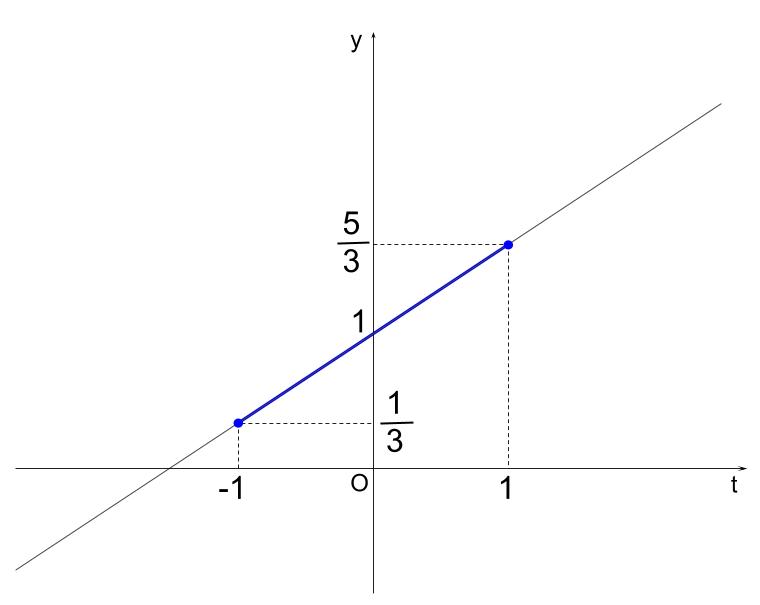三角関数を含む関数の最大値・最小値
ポイント
最大値、最小値は、グラフをかいて解きましょう。
結局は、\(1\) 次関数か \(2\) 次関数の処理になります。
\(\sin \theta=t\) あるいは \(\cos \theta=t\) などと置き換えて
\(t\) の \(1\) 次関数(直線)として解きましょう。
あるいは、
\(\sin^2 \theta +\cos^2 \theta =1\)
を用いて、\(\sin \theta\) あるいは \(\cos \theta\) だけの \(2\) 次式にします。
その後は \(\sin \theta=t\) あるいは \(\cos \theta=t\) などと置き換えて、
\(t\) の \(2\) 次関数(放物線)の処理です。
いずれの場合も、\(t\) の取り得る値の範囲に注意しましょう。
例題1
\(0 \leqq \theta \lt 2\pi\) のとき、次の関数の最大値、最小値 を求めなさい。
また、そのときの \( \theta \) の値を求めなさい。
\(y=\displaystyle \frac{2}{3}\sin \theta +1\)
解説
\(\sin \theta\) を \(t\) とおくと \(-1 \leqq t \leqq 1\) ・・・①
このとき、\(y=\displaystyle \frac{2}{3}\sin \theta +1\) は、
\(y=\displaystyle \frac{2}{3}t +1\)
グラフは①の範囲で以下のようになります。

グラフより、
\(t=-1\) のとき、最小値 \(\displaystyle \frac{1}{3}\)、\(t=1\) のとき、最大値 \(\displaystyle \frac{5}{3}\) です。
つまり、
\(t=\sin \theta =-1\) のとき、 \(\theta =\displaystyle \frac{3}{2}\pi\) なので、\(\theta =\displaystyle \frac{3}{2}\pi\) で、最小値 \(\displaystyle \frac{1}{3}\)
\(t=\sin \theta=1\) のとき、 \(\theta =\displaystyle \frac{\pi}{2}\) なので、\(\theta =\displaystyle \frac{\pi}{2}\) で、最大値 \(\displaystyle \frac{5}{3}\)
例題2
\(0 \leqq \theta \lt 2\pi\) のとき、次の関数の最大値、最小値 を求めなさい。
また、そのときの \( \theta \) の値を求めなさい。
\(y=\sin^2 \theta – \cos \theta +1\)
解説
\(\sin^2 \theta +\cos^2 \theta =1\) を用いて、
\(y=\sin^2 \theta – \cos \theta +1\) を \(\cos \theta\) だけの式にします。
\(y=(1-\cos^2 \theta) – \cos \theta +1\)
\(y=-\cos^2 \theta – \cos \theta +2\)
\(\cos \theta =t\) とおくと \(-1 \leqq t \leqq 1\) ・・・①
このとき、\(y=-\cos^2 \theta – \cos \theta +2\) は、
\(y=-t^2-t+2\)
平方完成してグラフをかきます。
\(y=-(t+\displaystyle \frac{1}{2})^2+\displaystyle \frac{9}{4}\)
また、\(y=-t^2-t+2=-(t-1)(t+2)\) なので、 \(t\) 軸との交点もわかります。
①の範囲でグラフは以下のようになります。

グラフより、
\(t=-\displaystyle \frac{1}{2}\) つまり、\(\cos \theta =-\displaystyle \frac{1}{2}\) で最大値 \(\displaystyle \frac{9}{4}\) をとり、
\(t=1\) つまり、\(\cos \theta =1\) で最小値 \(0\) をとります。
\(0 \leqq \theta \lt 2\pi\) で \(\theta\) について解くと、
\(\cos \theta =-\displaystyle \frac{1}{2}\) つまり、 \(\theta =\displaystyle \frac{2}{3}\pi, \displaystyle \frac{4}{3}\pi\) のとき、最大値 \(\displaystyle \frac{9}{4}\)
\(\cos \theta =1\) つまり、\(\theta =0\) のとき、最小値 \(0\)